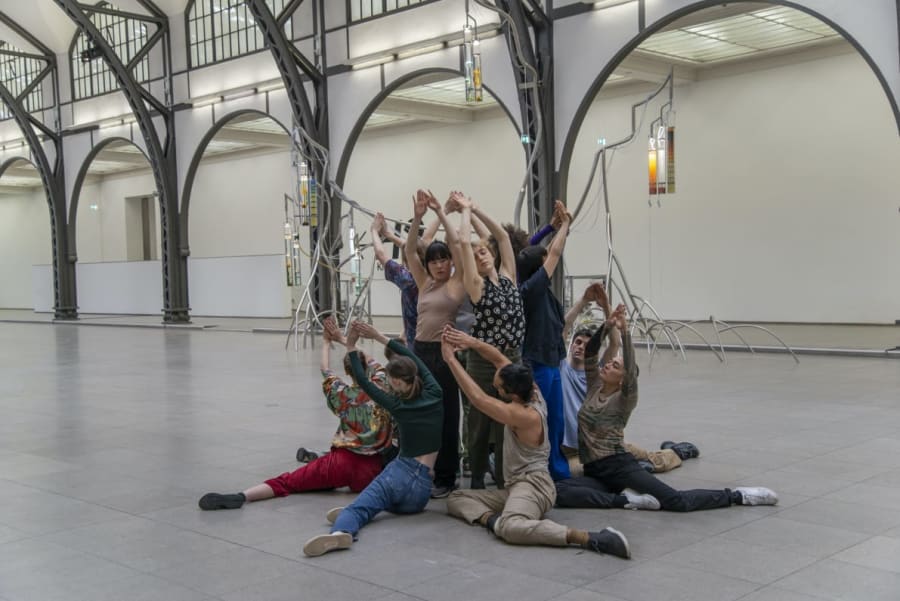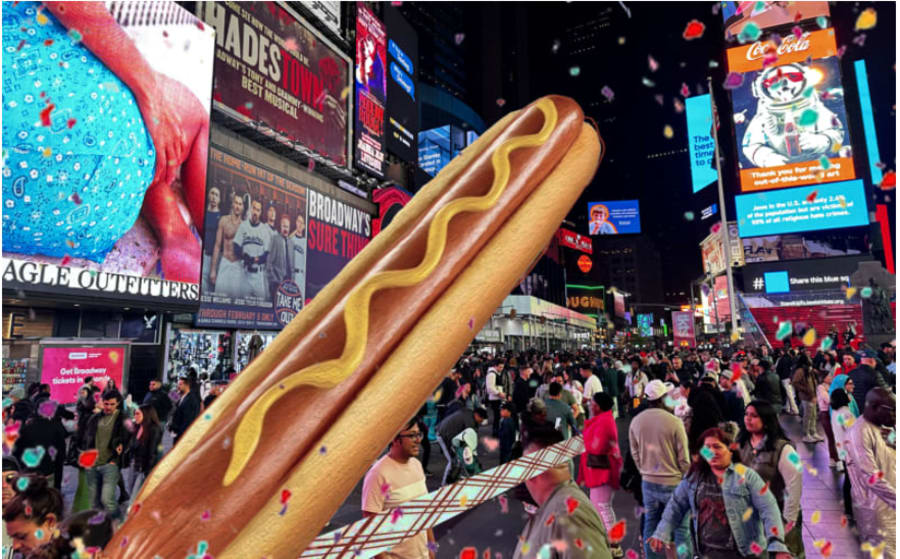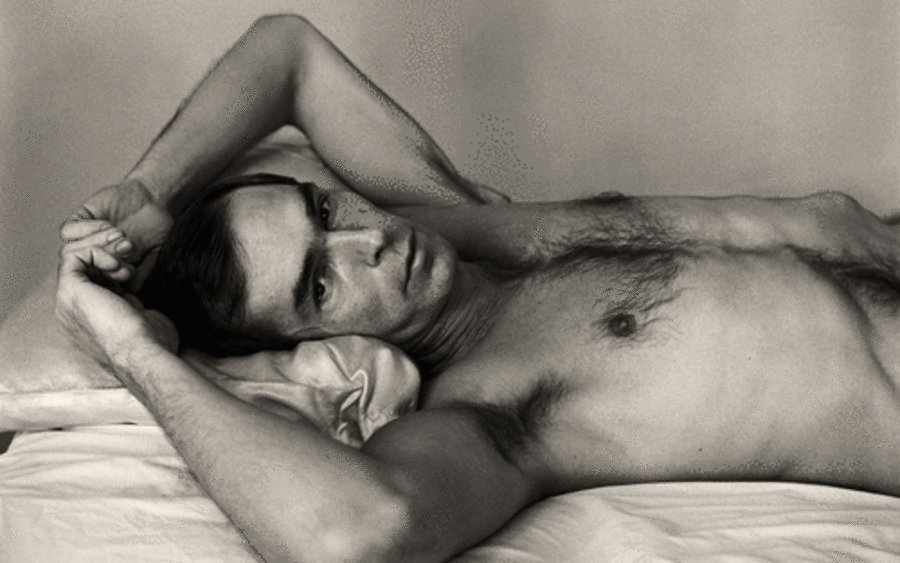Last year, Joe Scotland, the director of Studio Voltaire in London, was on a video call with the granddaughter of the late British artist Beryl Cook (1926–2008). Scotland has been a fan of Cook’s work for a long time – going against an art-world snobbery that has long regarded her paintings of big women and working-class life as mere seaside humor. Having her work on view as Studio Voltaire hits its 30th anniversary seemed a fitting echo to the institution’s history of irreverence. But that wasn’t to be all.
During the conversation, Scotland broached his idea of showing Cook’s work alongside that of Tom of Finland (1920–1991). ‘I saw Sophie [Howe, Beryl Cook’s granddaughter] typing the name into Google and her eyes widened. She said she’d have to talk to her dad.’ On the screen would have been Tom’s drawings of muscle-bound, leather-clad men, many sporting enormous erections, indulging in outdoor sex, or having their bottoms spanked. ‘We were worried we had offended them, but then the family came back very quickly and they had all agreed that Beryl would have loved the idea.’
‘We are not being shy with the work: Some of the more recent presentations of Tom’s work have been a bit PG – we are going XXX. When we shared the near-final list of works with Beryl’s family I was again nervous, but they were totally onboard.’
‘They understood it contextualized Beryl’s work in relation to LGBT history and representation. Beryl was a straight woman with a husband and children but there are paintings of gay bars and clubs; most of her friends were gay men and women.’
Both Cook and Tom of Finland were self-taught, and their careers were initially centered on illustration and commercial commissions. Touko Valio Laaksonen – as Tom of Finland was initially known – first started submitting his drawings to Physique Pictorial, an American gay magazine masquerading as a fitness title, when he was 36. Mailing the work from his home in Finland, he used Tom as a pseudonym. Cook, six years his junior, was a former model and showgirl who was running a guesthouse in Plymouth on England’s south coast when she had her first show in 1975 at the local arts center. It led to illustrations for The Sunday Times and other media, and spawned a plethora of merchandise from prints and books to postcards and tea towels.
Tom of Finland ran his career as a cottage industry, says Nicola Wright, the curator at Studio Voltaire. ‘Tom would draw in series. The first images, which were the cleaner ones, would appear in a title like Physique Pictorial; you’d have to write in and send money in order to access the more explicit pictures. A lot of his work was distributed and bootlegged that way. And then, Tom himself was also distributing the work by himself, literally gifting drawings to men that he liked.’ Cook was equally generous. ‘Going through her archives we found that she replied to every single one of the fan letters she received. Each is dated and signed as to when she replied to them, and what was sent back,’ Wright says. ‘Lots of them are people writing “I love your work, but I can’t afford a painting. Would you sign this postcard for me instead? Would you send me a postcard for my collection?” There’s so much care put into that correspondence.’
Scotland says of Cook, ‘Putting her with Tom of Finland also emphasizes their shared interest in bodies – voluptuous bodies – and really brings out the socio-political aspect of the work.’ Like Tom’s drawing of men cruising or beefcakes and bikers copping off – such as one drawing from ‘The Tattooed Sailor’ series (1962) in which a tiny-trunked hunk flirtatiously pushes two other highly-inked seamen into the water – in Cook’s work, working class women are also enjoying themselves – sexually liberated and full of confidence. In Elvira’s Café (1997) the aproned owner is carrying a huge slice of cake over to a customer, but her attention is caught by a man in skimpy shorts and a sports vest. Cook cited the social realism of Edward Burra (1905–1976) and Stanley Spencer (1891–1959) as inspiration, and her works share the same mix of irreverence and poignancy. The Lockyer Tavern (c. 1974) shows a back bar of a hotel where those who found themselves otherwise edged out of society found a home. A couple of men prop up the bar, perhaps the tavern’s gay clientele, while a woman with an enormous cleavage and red dangling earrings, possibly a sex worker, bends over provocatively in front of an older gent. More explicit is Cook’s wonderful “Bangs” Disco (1977), a painting of the legendary London nightclub (which evolved into the nightlife mainstay G.A.Y.), the dance floor full of denim-clad men dancing and embracing.
By the 1990s, Tom of Finland was being championed by the likes of Robert Mapplethorpe (1946–1989), and Durk Dehner, a publisher who is now president of the artist’s foundation. While his first show was in a Berlin sex shop, exhibitions have since been held at the Museum of Contemporary Art, Los Angeles and commercial galleries including David Kordansky Gallery, also in Los Angeles, and Galerie Judin in Berlin. While her books sold in their millions, and she collaborated on a television show, exhibitions for Cook have been rarer.
Studio Voltaire initially had trouble locating many of the paintings. To source them, they put out a public call – and the response was phenomenal. ‘The people contacting us were not your standard collectors, just ordinary people who loved the work. Most of the works have barely changed hands since they were bought from Beryl,’ Wright says. While prices now range from £12,000 to £30,000, during her lifetime people could buy a painting for as little as a few hundred pounds.
‘We had more offers than we could possibly take and we wanted to focus on Beryl’s work depicting women, and particularly women enjoying themselves,’ Scotland adds. Ladies Night (1981), for example, shows a famed stripper Cook saw perform named Ivor Dickie, surrounded by his cheerful female fans, evidently having a good time. The work is lent by Gay Search, who British readers might recognize as a presenter of genteel BBC horticultural advice show, Gardeners’ World.
In 2007, Adrian Searle, the art critic for The Guardian, discounted Cook as someone who ‘makes art for people who don’t much like art.’ In reframing Cook’s work as an ode to body positivity, Queer inclusivity, and working-class life, Scotland and Wright are seeking to change that perception and they believe their timing is right. ‘There’s renewed interest in figurative painting, and particularly work that touches on grotesque, activated bodies,’ Scotland says. ‘I always find it interesting to show Beryl’s work to artists, especially international ones who can look at it without all the baggage the British come with. They find the foregrounding of women, especially the voice of working-class women, fascinating.’
Oliver Basciano is a journalist and critic based in São Paulo and London.
Caption for full-bleed image: Beryl Cook, The Lockyer Tavern (detail), c. 1974. Courtesy of the Beryl Cook Estate.
Published on May 13, 2024.


